-
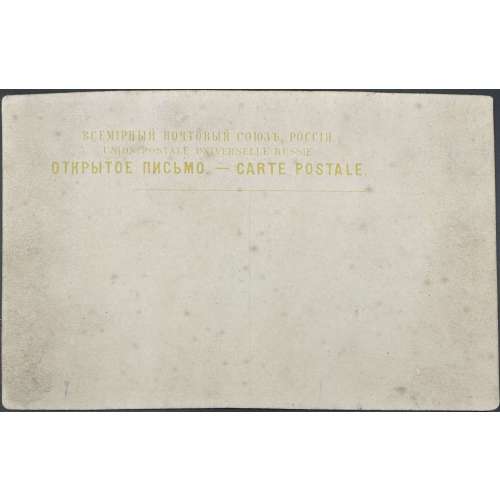 Ten postcards 90 x 140 mm, text in yellow "ВСЕМIРНЫЙ ПОЧТОВЫЙ СОЮЗЪ. РОССIЯ. | UNION POSTALE UNIVERSELLE RUSSIE. | ОТКРЫТОЕ ПИСЬМО. — CARTE POSTALE. || On the reverse, a blue ink woodcut image is printed in the upper left corner, and a blue ink numbered image title is in the bottom centre. Holding the postcard against the backlight reveals a hidden image of an indecent nature (erotic). The use of Latin characters "R" and "N" instead of Russian "Р" and "Н" suggests that the cards were produced in Europe, probably in France. Inscriptions: 1. ПЕRВЫЕ ДNИ; 2. ПОRА ЛЮБВИ; 3. ВЪ ЛЮДИ; 4. КЪ "СВОБОДNОМУ ИСКУССТВУ"; 5. "СВОБОДNЫЙ ТRУДЪ; 6. БЕЗЪ ГОRЯ И ПЕЧАЛИ; 7. NАЗАДЪ КЪ "СВОБОДNОЙ ЛЮБВИ"; 8. ВСЕ ЧТО ОСТАЛОСЬ!; 9. БЕЗЪ КRОВА И ПRИСТАNИЩА; 10. ИЗЪ ЗА ХЛѢБА.
Ten postcards 90 x 140 mm, text in yellow "ВСЕМIРНЫЙ ПОЧТОВЫЙ СОЮЗЪ. РОССIЯ. | UNION POSTALE UNIVERSELLE RUSSIE. | ОТКРЫТОЕ ПИСЬМО. — CARTE POSTALE. || On the reverse, a blue ink woodcut image is printed in the upper left corner, and a blue ink numbered image title is in the bottom centre. Holding the postcard against the backlight reveals a hidden image of an indecent nature (erotic). The use of Latin characters "R" and "N" instead of Russian "Р" and "Н" suggests that the cards were produced in Europe, probably in France. Inscriptions: 1. ПЕRВЫЕ ДNИ; 2. ПОRА ЛЮБВИ; 3. ВЪ ЛЮДИ; 4. КЪ "СВОБОДNОМУ ИСКУССТВУ"; 5. "СВОБОДNЫЙ ТRУДЪ; 6. БЕЗЪ ГОRЯ И ПЕЧАЛИ; 7. NАЗАДЪ КЪ "СВОБОДNОЙ ЛЮБВИ"; 8. ВСЕ ЧТО ОСТАЛОСЬ!; 9. БЕЗЪ КRОВА И ПRИСТАNИЩА; 10. ИЗЪ ЗА ХЛѢБА. -
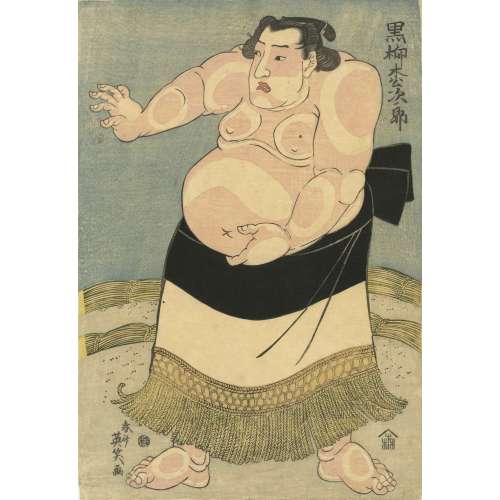 This print was sold to me with the following description: "Ikkansai EISHO (Fl. early 19th c.). A portrait of the wrestler Kuroyanagi Matsujiro, ring name Kumagatake Inosuke. Eisho was a pupil of Eishi. Published c. 1820s by Uoya Eikichi. Signed Shunsai Eisho ga." As a result of our joint effort with my beloved sister, we have so far found the following: The artis is mentioned in The Hotei Encyclopedia of Japanese Woodblock Prints, 2005, Vol 2; p. 438 under the name of Harukawa Eichō. From this source we learned that the artist was active from about 1818 till 1844, and was a print designer in Kyoto. He was a student first of Harukawa Goshichi and later studied in Edo (Tokyo) with Keisai Eisen, when he assumed the art name 'Eichō'. Other names: Shunsai. The Japanese web page dedicated to Harukawa Eichō provides more details: The artist lived from the 4th year of Tenmei ( 1784 ) to the first year of Kaei ( 1848 ). He was a student of Harukawa Goshichi, Kikukawa Eizan as well as of Keisai Eisen. His popular name was Kamenosuke. He was from Kyoto. He took "gagō" (artistic names) of Eishō when he was a student of Harukawa Goshichi; later, when he became a student of Kikukawa Eizan and Keisai Eisen he took the name of Kikukawa Eichō. The artist was mostly known for his bijinga (beautiful women) prints as well as kanazōshi illustrations. Nothing is said anywhere about his sumo prints, though the reference to another Kyushu sumo wrestler portrait has been found. The sumo wrestler Kuroyanagi Matsujiro is also a somewhat obscure figure: information about his life and career is quite inconsistent. It may so happened that two different persons were combined together. Wikipedia page about Aoi Aso Jinja, a Shinto shrine in Hitoyoshi in Kumamoto prefecture, tells us the following:This information has some inconsistencies already. If our hero was born in 1807 and promoted to ōzeki at the age of 32, it should have been the year 1839, not 1847. I found Kumagatake Isuke at "Sumo Reference" website:
This print was sold to me with the following description: "Ikkansai EISHO (Fl. early 19th c.). A portrait of the wrestler Kuroyanagi Matsujiro, ring name Kumagatake Inosuke. Eisho was a pupil of Eishi. Published c. 1820s by Uoya Eikichi. Signed Shunsai Eisho ga." As a result of our joint effort with my beloved sister, we have so far found the following: The artis is mentioned in The Hotei Encyclopedia of Japanese Woodblock Prints, 2005, Vol 2; p. 438 under the name of Harukawa Eichō. From this source we learned that the artist was active from about 1818 till 1844, and was a print designer in Kyoto. He was a student first of Harukawa Goshichi and later studied in Edo (Tokyo) with Keisai Eisen, when he assumed the art name 'Eichō'. Other names: Shunsai. The Japanese web page dedicated to Harukawa Eichō provides more details: The artist lived from the 4th year of Tenmei ( 1784 ) to the first year of Kaei ( 1848 ). He was a student of Harukawa Goshichi, Kikukawa Eizan as well as of Keisai Eisen. His popular name was Kamenosuke. He was from Kyoto. He took "gagō" (artistic names) of Eishō when he was a student of Harukawa Goshichi; later, when he became a student of Kikukawa Eizan and Keisai Eisen he took the name of Kikukawa Eichō. The artist was mostly known for his bijinga (beautiful women) prints as well as kanazōshi illustrations. Nothing is said anywhere about his sumo prints, though the reference to another Kyushu sumo wrestler portrait has been found. The sumo wrestler Kuroyanagi Matsujiro is also a somewhat obscure figure: information about his life and career is quite inconsistent. It may so happened that two different persons were combined together. Wikipedia page about Aoi Aso Jinja, a Shinto shrine in Hitoyoshi in Kumamoto prefecture, tells us the following:This information has some inconsistencies already. If our hero was born in 1807 and promoted to ōzeki at the age of 32, it should have been the year 1839, not 1847. I found Kumagatake Isuke at "Sumo Reference" website:Kuroki Matsujiro (黒木松次郎) was born in the village of Itsuki in Kuma district, Kumamoto prefecture, island of Kyushu in Bunka era, 4th year (1807). Since from his childhood he was blessed by great physique and tough strength. He had affection for sumo. At the age of 18 he became a sumo student of Kumamoto Shimakawa Ikuhei and took the name of Toyama Hidekichi (遠山日出吉). At the age of 23 (1830), he entered sumo stables in Kyoto, mastered the art of taming of young horses, and his talents improved. At the age of 31 he went to Edo, and became a disciple of the ōzeki Oitekaze Kitaro of Hirado domain in Hizen province, also from Kyushu island. After that, he changed his name and became Kuroyanagi Matsujiro (黒柳松次郎 – as on the print). In 1847 (Bunka era, 4th year) he distinguished himself by advancing to the first grade, and at the age of 32 he was promoted to ozeki level, becoming sekitori. After changing his name to Kuma-ga-take Inosuke (熊ヶ嶽猪之介 / くまがたけいのすけ) he displayed further efforts, and became one of the strongmen that fermented sumo wrestling in Edo. In 1853 (Kaei era, 6th year) he retired and returned to his village, becoming an employee as a strongman of Sagara domain (相良藩), and worked hard as instructor of the sumo training hall to train successors until 1855 (Ansei era, 2nd year) when he passed away at the age of 48. Even today Kuma-ga-take's home exists in Itsukimura (his native village). Also, on those grounds a descendant of Kuma-ga-take runs minshuku (guest house) that bears the name of "The Kuroki Pension (lodging) ", and tourists come to visit from various parts of Japan. In 2015, tenth month, within the borders of Aoi Aso Shrine there was built a gravestone publicly honoring Kuma-ga-take Inosuke, sumo wrestler from Edo / of Edo period.
The real name is the same, the ring name Kuroyanagi Matsujiro is the same, however, the date of birth here is 1815. He fought from 1836 till 1853 - which is quite similar to "At the age of 31 he went to Edo, and became a disciple of the ōzeki Oitekaze Kitaro". Though, in 1836 he might be 29 years old. His bouts are listed from spring 1841 to spring 1848 under the name of Kuroyanagi and from winter 1848 till spring 1853 he listed under the name of Kumagatake Isuke [Inosuke].Highest Rank Maegashira 4 Real Name Kuroki Birth Date 1815 Shusshin Kumamoto-ken, Kuma-gun Death Date March 6, 1855 (40 years) Heya Oitekaze Shikona Kuroyanagi Matsujiro - Kumagatake Isuke Hatsu Dohyo 1836.02 (Sandanme) Intai 1853.02 On another important sumo history website, I found that Kuroyanagi first appeared at ring in the spring of 1823 (he might have been 16 years old then, which does not seem right). Then, in the winter tournament of 1848 Kuroyanagi took the name Kumagatake. At the spring tournament of 1853 Kumagatake (Kuroyanagi) retired. This is quite consistent so far.
Then, I found Oitekaze Kitaro, allegedly the teacher of Kuroyanagi.
Everything look good with an exception of ring names (shikona): Kuroyanagi Matsujiro (1823-1828) - Kuroyanagi Sumiemon (1829-30) - Oitekaze Kitaro (1831-1839). May it be that Sato Matsutaro fought under the name of Kuroyanagi Matsujiro until Kuroki Matsujiro took this name from his master? I don't have another explanation of the enigma. What we know is that we have a portrait of a sumo wrestler called Kuroyanagi Matsujiro from Kyushu, but we don't know whether this was the one from Kumamoto (Kumagatake Inosuke, 1807/1815-1855) or the other from Kanagawa (Oitekaze Kitaro, 1799-1865). Subsequently, we may declare that the artist is Shunsai Eishō, a.k.a.Harukawa Eichō from Eishi school (The Hotei Encyclodepdia, p. 524), we can date the print from 1818 to 1844, and only tell that the wrestler is Kuroyanagi Matsujiro from Kyushu (either Kumagatake Inosuke or Oitekaze Kitaro). The publisher of the print is Moriya Jihei (Marks №353, p. 243-5). That's it.Highest Rank Ozeki Real Name SATO Matsujiro (Matsutaro#) Birth Date 1799 Shusshin Kanagawa-ken, Tsukui-gun Death Date May 4, 1865 (66 years) Heya Oitekaze Shikona Kuroyanagi Matsujiro - Kuroyanagi Sumiemon - Oitekaze Kitaro Hatsu Dohyo 1817.10 (Jonokuchi) Intai 1839.03 -
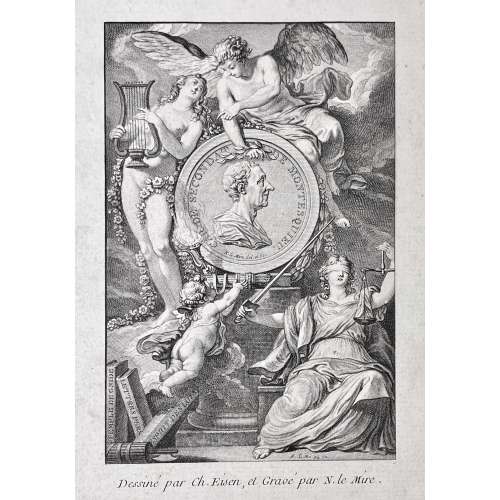 Hardcover volume, 8vo, 24.3 x 16.5 cm, bound in contemporary full marbled calf, spine with raised bands, gilt floral tools in compartments, gilt title lettering, marbled end-papers and all edges, printed on laid paper 23.9 x 5.5 cm with a watermark, entirely engraved (frontispiece, title, nine plates, and text), gatherings not indicated. Title-page (engraved, vignette, tall 's') LE | TEMPLE | DE | GNIDE | Nouvelle Edition, | Avec Figures | Gravées par N. LE MIRE, | des Acad. De Vienne en Autriche et de Rouen, | D’apres les Dessins de Ch. Eisen. | Le Texte Gravé par Droüet. | — | {3 lines quotation from Gallien} | A PARIS | Chez le Mire Graveur | Rue St. Etienne des Gres. | AVEC PRIVELEGE DU ROI. | 1772. || Frontispiece (engraved, vignette): Portrait medallion inscribed "CHARLES SECONDAT DE MONTESQUIEU — N. Le Mire del et sc", signed beneath "N. le Mire sculp 1771"; under the plate: "Dessiné par Ch. Eisen, et Gravé par N. le Mire." Pagination: frontispiece, t.p. / explication, dedication, [i] ii-vii [viii blank] 1-104 [105-6 blanks]; engraved throughout, plus 9 plates by Le Mire after Eisen.Catalogue Raisonné: Cohen-de Ricci 726-27; Ray, French Illustrated Book, №32/p. 61-2.Ref.: MFA (Boston): Accession Number 37.1726.Charles Eisen (French, 1720 – 1778) – artist. Noël Le Mire (French, 1724 – 1801) – engraver, publisher. Droüet (French, 18th century) – text engraver. Charles Louis de Secondat, Baron de La Brède et de Montesquieu (French, 1689 – 1755) – author.
Hardcover volume, 8vo, 24.3 x 16.5 cm, bound in contemporary full marbled calf, spine with raised bands, gilt floral tools in compartments, gilt title lettering, marbled end-papers and all edges, printed on laid paper 23.9 x 5.5 cm with a watermark, entirely engraved (frontispiece, title, nine plates, and text), gatherings not indicated. Title-page (engraved, vignette, tall 's') LE | TEMPLE | DE | GNIDE | Nouvelle Edition, | Avec Figures | Gravées par N. LE MIRE, | des Acad. De Vienne en Autriche et de Rouen, | D’apres les Dessins de Ch. Eisen. | Le Texte Gravé par Droüet. | — | {3 lines quotation from Gallien} | A PARIS | Chez le Mire Graveur | Rue St. Etienne des Gres. | AVEC PRIVELEGE DU ROI. | 1772. || Frontispiece (engraved, vignette): Portrait medallion inscribed "CHARLES SECONDAT DE MONTESQUIEU — N. Le Mire del et sc", signed beneath "N. le Mire sculp 1771"; under the plate: "Dessiné par Ch. Eisen, et Gravé par N. le Mire." Pagination: frontispiece, t.p. / explication, dedication, [i] ii-vii [viii blank] 1-104 [105-6 blanks]; engraved throughout, plus 9 plates by Le Mire after Eisen.Catalogue Raisonné: Cohen-de Ricci 726-27; Ray, French Illustrated Book, №32/p. 61-2.Ref.: MFA (Boston): Accession Number 37.1726.Charles Eisen (French, 1720 – 1778) – artist. Noël Le Mire (French, 1724 – 1801) – engraver, publisher. Droüet (French, 18th century) – text engraver. Charles Louis de Secondat, Baron de La Brède et de Montesquieu (French, 1689 – 1755) – author. -
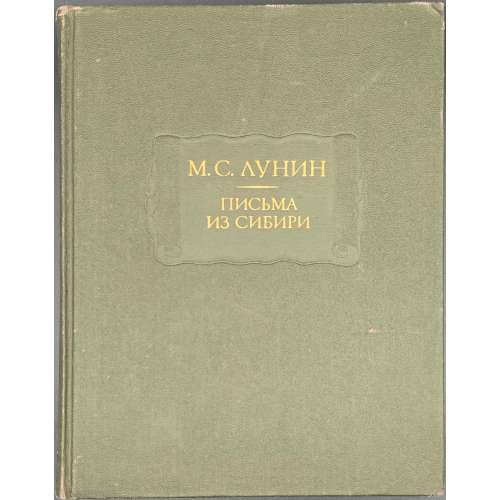 Title (black and red): М. С. ЛУНИН | — | ПИСЬМА ИЗ СИБИРИ | — | Издание подготовили | И. А. Желвакова и Н. Я Эйдельман | МОСКВА | «НАУКА» | 1987 || Pagination: [1, 2] Serial h.t. / blank, [3, 4] t.p. / imprint, [5] 6-492 [4], 1 portrait and 8 leaves of plates. Collation: 16mo; [1]16 216 38 (plates), 4-1716. Binding: serial green buckram blind-stamped with a scroll adorned with gold lettering to board and spine.
Title (black and red): М. С. ЛУНИН | — | ПИСЬМА ИЗ СИБИРИ | — | Издание подготовили | И. А. Желвакова и Н. Я Эйдельман | МОСКВА | «НАУКА» | 1987 || Pagination: [1, 2] Serial h.t. / blank, [3, 4] t.p. / imprint, [5] 6-492 [4], 1 portrait and 8 leaves of plates. Collation: 16mo; [1]16 216 38 (plates), 4-1716. Binding: serial green buckram blind-stamped with a scroll adorned with gold lettering to board and spine. -
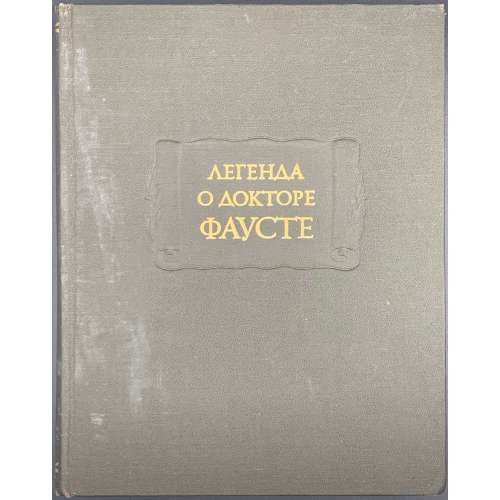 Title (black lettering, red elements): ЛЕГЕНДА | О ДОКТОРЕ | ФАУСТЕ | {element} | ИЗДАНИЕ ПОДГОТОВИЛ | В. М. ЖИРМУНСКИЙ | ВТОРОЕ, ИСПРАВЛЕННОЕ ИЗДАНИЕ | ИЗДАТЕЛЬСТВО «НАУКА» | МОСКВА 1978 || Pagination:[1-5] 6-421 [3]; +3 leaves of plates. Collation: 8vo; [1]8 2-278. Binding: 22 x 17.5 cm, serial green buckram blind-stamped with a scroll adorned with gold lettering to board and spine. Contents:
Title (black lettering, red elements): ЛЕГЕНДА | О ДОКТОРЕ | ФАУСТЕ | {element} | ИЗДАНИЕ ПОДГОТОВИЛ | В. М. ЖИРМУНСКИЙ | ВТОРОЕ, ИСПРАВЛЕННОЕ ИЗДАНИЕ | ИЗДАТЕЛЬСТВО «НАУКА» | МОСКВА 1978 || Pagination:[1-5] 6-421 [3]; +3 leaves of plates. Collation: 8vo; [1]8 2-278. Binding: 22 x 17.5 cm, serial green buckram blind-stamped with a scroll adorned with gold lettering to board and spine. Contents:- Исторические и легендарные свидетельства о докторе Фаусте / Пер. С. А. Акулянц.
- Народная книга: История о докторе Иоганне Фаусте, знаменитом чародее и чернокнижнике / Пер. Р. В. Френкель.
- Свидетельства о постановке народной драмы и кукольной комедии / Пер. С. А. Акулянц
- Кукольные комедии / Пер. H. A. Сигал: (1) Доктор Иоганн Фауст; (2) Доктор Фауст, или Великий Негромант; (3) Иоганнес Фауст.
- Кристофер Марло. Трагическая история доктора Фауста / Пер. H. H. Амосовой.
- «Фауст» Лессинга / Пер. В. Е. Гаккель-Аренс.
- Комментарии: В. М. Жирмунский. История легенды о Фаусте.
- Примечания / Сост. В. М. Жирмунский; к «Фаусту» Марло — H. H. Амосова.
-
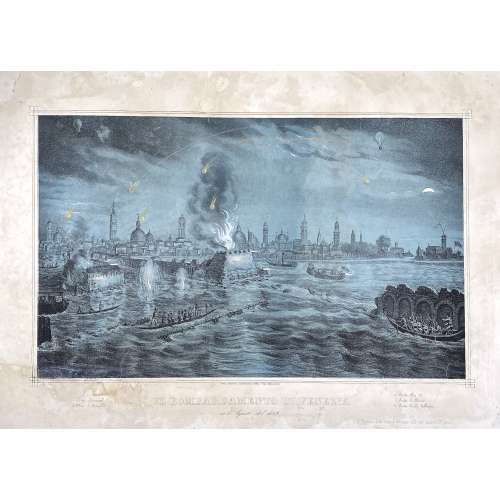 Quaritch's description: Single sheet (435 x 625 mm); coloured lithograph by Kirchmayr after a drawing by M. Fontana; hand-painted details; signed to lower left ‘M. Fon[tana]’ and to lower right ‘M. Fontana Edit. Prop. S. Giacomo dall’Orio in Isola N°.1481’; lower margin with the title ‘Il bombardamento di Venezia nell’Agosto 1849’ and key; restored tears in many places, especially along upper and lower blank margins, some affecting print; losses to lower left corner, affecting a small portion of the print, ruled border, and key, restored and re-drawn where needed; loss to the upper left corner of blank margin; two small areas of restoration to the centre of upper blank margin; the whole sheet backed; nevertheless a remarkable survival. Exceedingly rare and striking lithograph of Venice as seen from Fusina, depicting the first ever aerial bombardment in history. The bombardment took place in 1849, under the orders of Field Marshal Josef Radetzky (1766–1858), to quell the revolts that had started the previous year during the First Italian War of Independence. This curious and little-known action was the brainchild of Colonel Benno Uchatius, a brilliant young officer in the Austro-Hungarian Artillery. After long months of unsuccessful siege, Uchatius decided to deploy an unusual weapon: a hot air balloon able to bomb the city from above. Having calculated the wind speed and direction and evaluated the requisite dimensions of the hot-air balloon, Uchatius set up a workshop near Mestre, where a group of engineers and craftsmen began to manufacture a balloon equipped with a large wicker basket which could transport two crewmen and approximately one hundred kilograms of small long-fuse devices (metal spheres filled with gunpowder, pitch, oil and five hundred rifle buckshot). The initial trials, however, proved to be a disaster, because the balloon would drift off course, making it impossible to accurately deploy the bombs. Uchatius then hit upon the idea of using several smaller unmanned balloons roped together. These were to be launched over the city and, using the position of the first ‘pilot’ balloon, which was unarmed, the Austrians could calculate the correct fuse settings for the bombs. The ‘bomber’ balloons had a cloth envelope of one hundred cubic metres and a reduced load of about twenty kilograms of ordnance. According to Uchatius’ calculations, the line of balloons, launched from Mestre, would reach the lagoon city in thirty-five to forty minutes, carried by the north-west wind. In July 1849, a first launch was attempted, but when a breeze began to blow from the sea some of the balloons broke the connecting ropes and floated away, while others settled in the water in front of the northern part of the city, where a curious crowd of Venetians observed the failure of the enterprise and commented colourfully on the ‘buffoonery of Radetzky’. Uchatius’ second attempt, which is depicted in this lithograph, was also largely unsuccessful: only a few of the unmanned bomber balloons reached their target, and some even drifted back over the Austrian lines. Uchatius, having accomplished the first ever aerial bombardment, and having designed the first ever military ‘drones’, was forced to abandon the project permanently. Another fascinating aspect of this work is the vantage point used to depict the city of Venice, seen here from Fusina, a very rare viewpoint that makes this piece even more remarkable. We were unable to locate any copies in any institution or bibliography. G. Kirchmayr (fl. mid-19th century) is mentioned at British Museum database as "Lithographer active in Venice; related to Venetian painter Cherubino Kirchmayr (b. 1848)?" However, I was not able to find that name on the print. Not much is known of M. Fontana either.
Quaritch's description: Single sheet (435 x 625 mm); coloured lithograph by Kirchmayr after a drawing by M. Fontana; hand-painted details; signed to lower left ‘M. Fon[tana]’ and to lower right ‘M. Fontana Edit. Prop. S. Giacomo dall’Orio in Isola N°.1481’; lower margin with the title ‘Il bombardamento di Venezia nell’Agosto 1849’ and key; restored tears in many places, especially along upper and lower blank margins, some affecting print; losses to lower left corner, affecting a small portion of the print, ruled border, and key, restored and re-drawn where needed; loss to the upper left corner of blank margin; two small areas of restoration to the centre of upper blank margin; the whole sheet backed; nevertheless a remarkable survival. Exceedingly rare and striking lithograph of Venice as seen from Fusina, depicting the first ever aerial bombardment in history. The bombardment took place in 1849, under the orders of Field Marshal Josef Radetzky (1766–1858), to quell the revolts that had started the previous year during the First Italian War of Independence. This curious and little-known action was the brainchild of Colonel Benno Uchatius, a brilliant young officer in the Austro-Hungarian Artillery. After long months of unsuccessful siege, Uchatius decided to deploy an unusual weapon: a hot air balloon able to bomb the city from above. Having calculated the wind speed and direction and evaluated the requisite dimensions of the hot-air balloon, Uchatius set up a workshop near Mestre, where a group of engineers and craftsmen began to manufacture a balloon equipped with a large wicker basket which could transport two crewmen and approximately one hundred kilograms of small long-fuse devices (metal spheres filled with gunpowder, pitch, oil and five hundred rifle buckshot). The initial trials, however, proved to be a disaster, because the balloon would drift off course, making it impossible to accurately deploy the bombs. Uchatius then hit upon the idea of using several smaller unmanned balloons roped together. These were to be launched over the city and, using the position of the first ‘pilot’ balloon, which was unarmed, the Austrians could calculate the correct fuse settings for the bombs. The ‘bomber’ balloons had a cloth envelope of one hundred cubic metres and a reduced load of about twenty kilograms of ordnance. According to Uchatius’ calculations, the line of balloons, launched from Mestre, would reach the lagoon city in thirty-five to forty minutes, carried by the north-west wind. In July 1849, a first launch was attempted, but when a breeze began to blow from the sea some of the balloons broke the connecting ropes and floated away, while others settled in the water in front of the northern part of the city, where a curious crowd of Venetians observed the failure of the enterprise and commented colourfully on the ‘buffoonery of Radetzky’. Uchatius’ second attempt, which is depicted in this lithograph, was also largely unsuccessful: only a few of the unmanned bomber balloons reached their target, and some even drifted back over the Austrian lines. Uchatius, having accomplished the first ever aerial bombardment, and having designed the first ever military ‘drones’, was forced to abandon the project permanently. Another fascinating aspect of this work is the vantage point used to depict the city of Venice, seen here from Fusina, a very rare viewpoint that makes this piece even more remarkable. We were unable to locate any copies in any institution or bibliography. G. Kirchmayr (fl. mid-19th century) is mentioned at British Museum database as "Lithographer active in Venice; related to Venetian painter Cherubino Kirchmayr (b. 1848)?" However, I was not able to find that name on the print. Not much is known of M. Fontana either. -
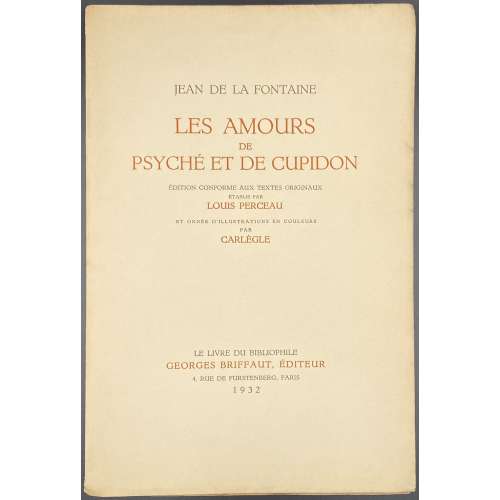 Softcover, 242 x 165 mm, French flapped wrappers with black and red lettering to front and spine, top edge trimmed, pages uncut, printed on wove paper watermarked BFK Rives in italic script; illustrations in colour. Title: JEAN DE LA FONTAINE | LES AMOURS | DE | PSYCHÉ ET DE CUPIDON | ÉDITION CONFORME AUX TEXTES ORIGINAUX | ÉTABLIE PAR | LOUIS PERCEAU | ET ORNÉE D’ILLUSTRATIONS EN COULEURS | PAR | CARLÈGLE | LE LIVRE DU BIBLIOPHILE | GEORGES BRIFFAUT, ÉDITEUR | 4, RUE DE FURSTENBERG, PARIS | 1932 || Limited edition: 1230 copies of which this ic copy № 247. Collated 8vo: π4 1-24 3-48 58 *58 6-168 χ2, total 134 leaves, incl. frontispiece. Pagination: [8] 1-253 [254] [6]. Colophon: Le volume des Amours de Psyché et de Cupidon de La Fontaine a été achevé d'imprimer le quinze juin mil neuf cent trente-deux sur les presses du maitre imprimeur Coulouma, a Argenteul, H. Barthélemy étant directeur. Coloris de E. Charpentier, Paris.
Softcover, 242 x 165 mm, French flapped wrappers with black and red lettering to front and spine, top edge trimmed, pages uncut, printed on wove paper watermarked BFK Rives in italic script; illustrations in colour. Title: JEAN DE LA FONTAINE | LES AMOURS | DE | PSYCHÉ ET DE CUPIDON | ÉDITION CONFORME AUX TEXTES ORIGINAUX | ÉTABLIE PAR | LOUIS PERCEAU | ET ORNÉE D’ILLUSTRATIONS EN COULEURS | PAR | CARLÈGLE | LE LIVRE DU BIBLIOPHILE | GEORGES BRIFFAUT, ÉDITEUR | 4, RUE DE FURSTENBERG, PARIS | 1932 || Limited edition: 1230 copies of which this ic copy № 247. Collated 8vo: π4 1-24 3-48 58 *58 6-168 χ2, total 134 leaves, incl. frontispiece. Pagination: [8] 1-253 [254] [6]. Colophon: Le volume des Amours de Psyché et de Cupidon de La Fontaine a été achevé d'imprimer le quinze juin mil neuf cent trente-deux sur les presses du maitre imprimeur Coulouma, a Argenteul, H. Barthélemy étant directeur. Coloris de E. Charpentier, Paris. -
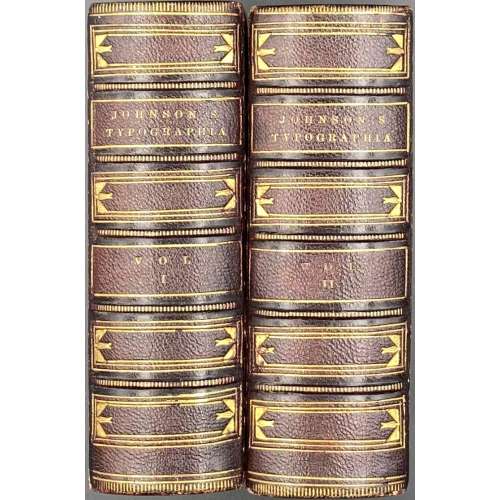 2 volume set, ¾ burgundy morocco over peacock marbled boards, ruled gilt, raised bands, gilt-ruled in compartments, gilt lettering, marbled endpapers and all margins, binding by W. S. Hiltz, NY. Vol. 1. Title: Typographia, | OR THE | Printers' Instructor: | INCLUDING AN ACCOUNT | of the | ORIGIN OF PRINTING, | with | Biographical Notices of the Printers of | England, from Caxton to the close | of the Sixteenth Century : | A Series of | Ancient and Modern Alphabets, | and | DOMESDAY CHARACTERS: | Together with | An Elucidation of every Subject con- | nected with the Art. | By J. JOHNSON, Printer. |{stanza}| Vol. I. | In frame: Published by Messrs. Longman, Hurst, | Rees, Orme, Brown & Green, Pater- | noster Row, London | Under the frame: 1824. || Pagination: Blank leaf, [2] – blank / engraved frontispiece (portrait of William Caxton by W. Hughes) w/guard, [2] – engraved t.p. by Thompson (upper margin almost none, tall lower margin, unframed) / blank, letterpress t.p. w/guard / blank, [2] – dedication to Earl Spenser and Roxburghe Club members / list of members, [2] – engraved Roxburgh Club plate by W. Hughes / blank, [4] – the pedigree of Earl Spenser, [i] ii-xii preface, [1] 2-610, [10] – index, blank leaf; printed on wove paper, text within double rule border. Vol. 2. Title: Typographia, | OR THE | Printers' Instructor: | INCLUDING AN ACCOUNT | of the | ORIGIN OF PRINTING, | with | Biographical Notices of the Printers of | England, from Caxton to the close | of the Sixteenth Century : | A Series of | Ancient and Modern Alphabets, | and | DOMESDAY CHARACTERS: | Together with | An Elucidation of every Subject con- | nected with the Art. | By J. JOHNSON, Printer. |{stanza}| Vol. II. | In frame: Published by Messrs. Longman, Hurst, | Rees, Orme, Brown & Green, Pater- | noster Row, London | Under the frame: 1824. || Pagination: Blank leaf, [2] – blank / engraved frontispiece (portrait of John Johnson ÆTATIS XLVI by William Harvey), w/o guard, [2] – engraved t.p. by G. W. Bonner (framed) / blank, letterpress t.p. w/o guard / blank, [2] – advert. / explanation of engraved title, [i]-iv contents, [1, 2] 3-663 [664], [14] – index, [2] – cantata, blank leaf; printed on wove paper, text within double rule border. Note: This is the book that served as a source of plagiarism for Adams's Typographia: a brief sketch of the origin, rise, and progress of the typographic art published in Philadelphia by himself in 1837.
2 volume set, ¾ burgundy morocco over peacock marbled boards, ruled gilt, raised bands, gilt-ruled in compartments, gilt lettering, marbled endpapers and all margins, binding by W. S. Hiltz, NY. Vol. 1. Title: Typographia, | OR THE | Printers' Instructor: | INCLUDING AN ACCOUNT | of the | ORIGIN OF PRINTING, | with | Biographical Notices of the Printers of | England, from Caxton to the close | of the Sixteenth Century : | A Series of | Ancient and Modern Alphabets, | and | DOMESDAY CHARACTERS: | Together with | An Elucidation of every Subject con- | nected with the Art. | By J. JOHNSON, Printer. |{stanza}| Vol. I. | In frame: Published by Messrs. Longman, Hurst, | Rees, Orme, Brown & Green, Pater- | noster Row, London | Under the frame: 1824. || Pagination: Blank leaf, [2] – blank / engraved frontispiece (portrait of William Caxton by W. Hughes) w/guard, [2] – engraved t.p. by Thompson (upper margin almost none, tall lower margin, unframed) / blank, letterpress t.p. w/guard / blank, [2] – dedication to Earl Spenser and Roxburghe Club members / list of members, [2] – engraved Roxburgh Club plate by W. Hughes / blank, [4] – the pedigree of Earl Spenser, [i] ii-xii preface, [1] 2-610, [10] – index, blank leaf; printed on wove paper, text within double rule border. Vol. 2. Title: Typographia, | OR THE | Printers' Instructor: | INCLUDING AN ACCOUNT | of the | ORIGIN OF PRINTING, | with | Biographical Notices of the Printers of | England, from Caxton to the close | of the Sixteenth Century : | A Series of | Ancient and Modern Alphabets, | and | DOMESDAY CHARACTERS: | Together with | An Elucidation of every Subject con- | nected with the Art. | By J. JOHNSON, Printer. |{stanza}| Vol. II. | In frame: Published by Messrs. Longman, Hurst, | Rees, Orme, Brown & Green, Pater- | noster Row, London | Under the frame: 1824. || Pagination: Blank leaf, [2] – blank / engraved frontispiece (portrait of John Johnson ÆTATIS XLVI by William Harvey), w/o guard, [2] – engraved t.p. by G. W. Bonner (framed) / blank, letterpress t.p. w/o guard / blank, [2] – advert. / explanation of engraved title, [i]-iv contents, [1, 2] 3-663 [664], [14] – index, [2] – cantata, blank leaf; printed on wove paper, text within double rule border. Note: This is the book that served as a source of plagiarism for Adams's Typographia: a brief sketch of the origin, rise, and progress of the typographic art published in Philadelphia by himself in 1837. -
![Конрад Н.И. Театр Кабуки, его история и теория // Японский театр. — Л.-М.: Academia — Всесоюзное Общество культурной связи с заграницей, 1928. — Тир. 3.200 экз. [Сборник статей под редакцией проф. Н. И. Конрада. В книге представлены статьи Н. Конрада, О. Плетнера, Д. Аркина, посвященные традиционному японскому театру. Объём книжки — 60 стр.].](https://varshavskycollection.com/wp-content/uploads/2021/02/LIB-0975.2016-a-scaled-500x500.jpeg) Title page: ВСЕСОЮЗНОЕ ОБЩЕСТВО КУЛЬТУРНОЙ СВЯЗИ С ЗАГРАНИЦЕЙ | ЯПОНСКИЙ ТЕАТР | СБОРНИК СТАТЕЙ | ПОД РЕДАКЦИЕЙ | ПРОФ. Н. И. КОНРАДА | ЛЕНИНГРАД 1928 МОСКВА || T.p. verso: Отпечатано по заказу Всесоюзного | Общества Культурной Связи с загра- | ницей издательством «ACADEMIA» | Государственного Института Истории | Искусств | Обложка работы | Н. А. И А. А. УШИНЫХ | Лениградский Областлит № 12814 […] Тираж 3200 экз. | 2-я типография Транспечати ГКПС, Ленинград, Улица Правды 15. || Bibliographical description: 21.5 x 17 cm; Publisher’s black pictorial wrappers, front cover with lettering: «ЯПОНСКИЙ ТЕАТР» | ВОКС ||, pp. [2] frontis., [2] t.p. / imprint, [2] h.t. / blank, [9] 10-59 [60] – content; collation: [1]7 2-38 46, (first leaf messing from the first gathering), 4 photo illustrations in collation, back black geometrical wrapper. Contents: Н. И. Конрад. Театр в Японии. Общий очерк. — с. 9. Его же. Театр Кабуки, его история и теория. — с. 15. Ол. Плетнер. Театр Кабуки. Социологический очерк. — с. 31. Д. Е. Аркин. Театр Кабуки. Формы и средства театральной выразительности. – c. 45. Personae: Конрад, Николай Иосифович (Russian, 1891 – 1970). Плетнер, Олег Викторович ( Russian, 1893 – 1929). Аркин, Давид Ефимович (Russian, 1899 – 1957). Ушин, Николай Алексеевич (Russian, 1898 – 1942). Ушин , Алексей Алексеевич (Russian, 1904 – 1942).
Title page: ВСЕСОЮЗНОЕ ОБЩЕСТВО КУЛЬТУРНОЙ СВЯЗИ С ЗАГРАНИЦЕЙ | ЯПОНСКИЙ ТЕАТР | СБОРНИК СТАТЕЙ | ПОД РЕДАКЦИЕЙ | ПРОФ. Н. И. КОНРАДА | ЛЕНИНГРАД 1928 МОСКВА || T.p. verso: Отпечатано по заказу Всесоюзного | Общества Культурной Связи с загра- | ницей издательством «ACADEMIA» | Государственного Института Истории | Искусств | Обложка работы | Н. А. И А. А. УШИНЫХ | Лениградский Областлит № 12814 […] Тираж 3200 экз. | 2-я типография Транспечати ГКПС, Ленинград, Улица Правды 15. || Bibliographical description: 21.5 x 17 cm; Publisher’s black pictorial wrappers, front cover with lettering: «ЯПОНСКИЙ ТЕАТР» | ВОКС ||, pp. [2] frontis., [2] t.p. / imprint, [2] h.t. / blank, [9] 10-59 [60] – content; collation: [1]7 2-38 46, (first leaf messing from the first gathering), 4 photo illustrations in collation, back black geometrical wrapper. Contents: Н. И. Конрад. Театр в Японии. Общий очерк. — с. 9. Его же. Театр Кабуки, его история и теория. — с. 15. Ол. Плетнер. Театр Кабуки. Социологический очерк. — с. 31. Д. Е. Аркин. Театр Кабуки. Формы и средства театральной выразительности. – c. 45. Personae: Конрад, Николай Иосифович (Russian, 1891 – 1970). Плетнер, Олег Викторович ( Russian, 1893 – 1929). Аркин, Давид Ефимович (Russian, 1899 – 1957). Ушин, Николай Алексеевич (Russian, 1898 – 1942). Ушин , Алексей Алексеевич (Russian, 1904 – 1942). -
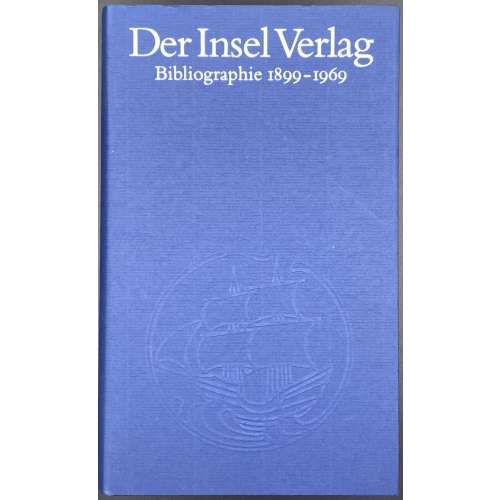 Title: DER INSEL VERLAG | EINE BIBLIOGRAPHIE | 1899-1969 | […] Bearbeitet und herausgegeben | von Heinz Sarkowski | INSEL VERLAG || Pagination: [i-vi] vii-xiii [xiv] [2] 1-452. Binding: Blue cloth, black label with gilt lettering to spine, lettered and blind-stamped DJ.
Title: DER INSEL VERLAG | EINE BIBLIOGRAPHIE | 1899-1969 | […] Bearbeitet und herausgegeben | von Heinz Sarkowski | INSEL VERLAG || Pagination: [i-vi] vii-xiii [xiv] [2] 1-452. Binding: Blue cloth, black label with gilt lettering to spine, lettered and blind-stamped DJ. -
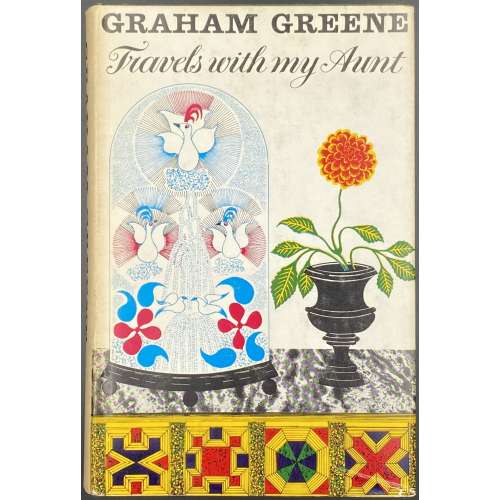 DJ: Graham Greene | Travels with my aunt || Title page: TRAVELS | WITH MY AUNT | A NOVEL | Graham Greene |{publisher’s device}| THE BODLEY HEAD | LONDON SYDNEY | TORONTO || Edition: 1st edition, 1st printing. Binding: 20.5 x 13.5 cm; publisher's green cloth, gilt lettering on spine, pictorial dust-jacket. Pagination: [1-8] 9 – 319 [320]. Collation: 16mo; [1]16, 2-1016 (total 160 leaves). Contributors: Graham Greene (British, 1904 – 1991) – author. Stephen Russ (British, 1919 – 1983) – DJ artist. The Bodley Head – publisher. William Clowes & Sons, Ltd. (Beccles) – printer.
DJ: Graham Greene | Travels with my aunt || Title page: TRAVELS | WITH MY AUNT | A NOVEL | Graham Greene |{publisher’s device}| THE BODLEY HEAD | LONDON SYDNEY | TORONTO || Edition: 1st edition, 1st printing. Binding: 20.5 x 13.5 cm; publisher's green cloth, gilt lettering on spine, pictorial dust-jacket. Pagination: [1-8] 9 – 319 [320]. Collation: 16mo; [1]16, 2-1016 (total 160 leaves). Contributors: Graham Greene (British, 1904 – 1991) – author. Stephen Russ (British, 1919 – 1983) – DJ artist. The Bodley Head – publisher. William Clowes & Sons, Ltd. (Beccles) – printer. -
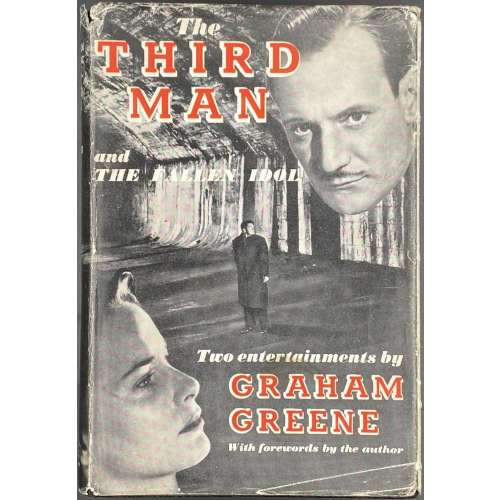 Title page: THE THIRD MAN | and | THE FALLEN IDOL | by | GRAHAM GREENE | {publisher’s device with lettering} |WILLIAM HEINEMANN LTD | MELBOURNE : : LONDON : : TORONTO || Title verso: FIRST PUBLISHED 1950 | PRINTED IN GREAT BRITAIN | AT THE WINDMILL PRESS | KINGSWOOD, SURREY || Pagination:[6] [1, 2] 3-188 [2] blank. Binding: publisher’s black cloth, silver lettering to spine, blind-stamped publisher’s device to back cover in the lower-right corner without lettering; publisher's pictorial dust jacket with lettering (white and read on b/w photo): The | THIRD | MAN | and | THE FALLEN IDOL | The entertainments by | GRAHAM | GREENE | With forewords by the author ||, price clipped. Size: 19 x 13 cm. Edition: 1st edition, 1st printing. Contributors: Graham Greene (British, 1904 – 1991) – author. William Henry Heinemann (British-Jewish, 1863 – 1920); William Heinemann Limited – publisher. The Windmill Press (Kingswood, Surrey) – printer.
Title page: THE THIRD MAN | and | THE FALLEN IDOL | by | GRAHAM GREENE | {publisher’s device with lettering} |WILLIAM HEINEMANN LTD | MELBOURNE : : LONDON : : TORONTO || Title verso: FIRST PUBLISHED 1950 | PRINTED IN GREAT BRITAIN | AT THE WINDMILL PRESS | KINGSWOOD, SURREY || Pagination:[6] [1, 2] 3-188 [2] blank. Binding: publisher’s black cloth, silver lettering to spine, blind-stamped publisher’s device to back cover in the lower-right corner without lettering; publisher's pictorial dust jacket with lettering (white and read on b/w photo): The | THIRD | MAN | and | THE FALLEN IDOL | The entertainments by | GRAHAM | GREENE | With forewords by the author ||, price clipped. Size: 19 x 13 cm. Edition: 1st edition, 1st printing. Contributors: Graham Greene (British, 1904 – 1991) – author. William Henry Heinemann (British-Jewish, 1863 – 1920); William Heinemann Limited – publisher. The Windmill Press (Kingswood, Surrey) – printer. -
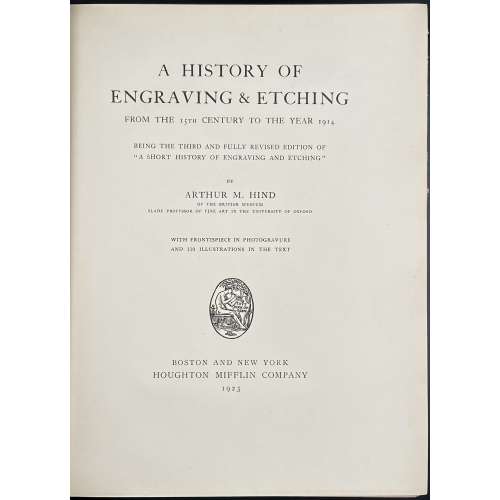 Title: A HISTORY OF | ENGRAVING & ETCHING | FROM THE 15TH CENTURY TO THE YEAR 1914 | BEING THE THIRD AND FULLY REVISED EDITION OF | “A SHORT HISTORY OF ENGRAVING AND ETCHING” | BY | ARTHUR M. HIND | OF THE BRITISH MUSEUM | SLADE PROFESSOR OF FINE ART IN THE UNIVERSITY OF OXFORD | WITH FRONTISPIECE IN PHOTOGRAVURE | AND 110 ILLUSTRATIONS IN THE TEXT | {publisher’s device} | BOSTON AND NEW YORK | HOUGHTON MIFFLIN COMPANY | 1923 || Pagination: [i-iv] v-xiii. [2] – blank / abbrev., [2] 3-487 [488], frontis. w/tissue guard, ills.; Appendices: I. Classified list of engravers (p. 343-392); II. General bibliography (p. 393-419); III. Index of engravers and individual bibliography (p. 420-487). Collation: π10 B-2H8 2I4, frontispiece (extr.), 110 in-text illustrations. Binding: 25.8 x 20 cm, crimson cloth, blind triple-fillet to top and bottom of the front board, same in gilt to spine, gilt lettering to spine, top edge gilt, fore-edge untrimmed. Contributors: Arthur Mayger Hind (British, 1880 – 1957) – author. Houghton Mifflin Company (Boston, 1864) – publisher. R & R. Clark, Ltd. (Edinburgh, 1846) – printer. Note: It is marked as the 3rd edition of A short history of engraving and etching. Indeed, A short history of engraving & etching for the use of collectors and students with full bibliography, classified list and index of engravers was published by Constable in London and Houghton Mifflin Co. in Boston, in 1908 and then in 1911. However, it is hard to consider an almost completely new book "a 3rd edition".
Title: A HISTORY OF | ENGRAVING & ETCHING | FROM THE 15TH CENTURY TO THE YEAR 1914 | BEING THE THIRD AND FULLY REVISED EDITION OF | “A SHORT HISTORY OF ENGRAVING AND ETCHING” | BY | ARTHUR M. HIND | OF THE BRITISH MUSEUM | SLADE PROFESSOR OF FINE ART IN THE UNIVERSITY OF OXFORD | WITH FRONTISPIECE IN PHOTOGRAVURE | AND 110 ILLUSTRATIONS IN THE TEXT | {publisher’s device} | BOSTON AND NEW YORK | HOUGHTON MIFFLIN COMPANY | 1923 || Pagination: [i-iv] v-xiii. [2] – blank / abbrev., [2] 3-487 [488], frontis. w/tissue guard, ills.; Appendices: I. Classified list of engravers (p. 343-392); II. General bibliography (p. 393-419); III. Index of engravers and individual bibliography (p. 420-487). Collation: π10 B-2H8 2I4, frontispiece (extr.), 110 in-text illustrations. Binding: 25.8 x 20 cm, crimson cloth, blind triple-fillet to top and bottom of the front board, same in gilt to spine, gilt lettering to spine, top edge gilt, fore-edge untrimmed. Contributors: Arthur Mayger Hind (British, 1880 – 1957) – author. Houghton Mifflin Company (Boston, 1864) – publisher. R & R. Clark, Ltd. (Edinburgh, 1846) – printer. Note: It is marked as the 3rd edition of A short history of engraving and etching. Indeed, A short history of engraving & etching for the use of collectors and students with full bibliography, classified list and index of engravers was published by Constable in London and Houghton Mifflin Co. in Boston, in 1908 and then in 1911. However, it is hard to consider an almost completely new book "a 3rd edition". -
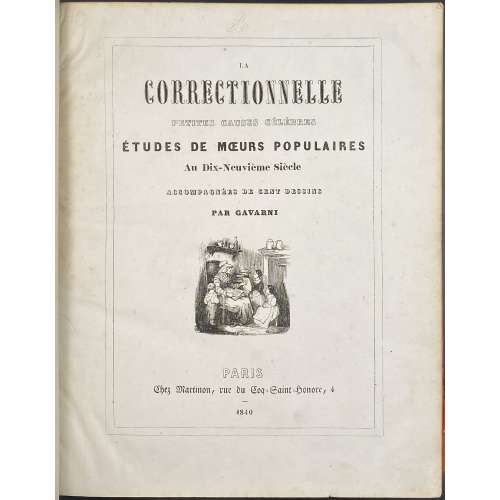 Title-page: LA | CORRECTIONNELLE | PETITES CAUSES CÉLÈBRES | ÉTUDES DE MŒURS POPULAIRES | Au Dix-Neuvième Siècle | ACCOMPAGNÉES DE CENT DESSINS | PAR GAVARNI | {woodcut vignette} | PARIS | Chez Martinon, rue du Coq-Saint-Honoré, 4 | 1840 || Collation: 2o, π3 (t.p. (wrapper?), h.t., t.p.), 1-1012; 205 leaves total, of them 100 plates, lithographs by Gavarni. Pagination: [6] [1] 2-403 [404], 410 pages total, incl. ils. (BnF calls for 426 pages total). Note: plate № 8 is numbered 9, plate № 9 numbered 8; p. 266 numbered 264, p. 268 numbered 266, p. 362 numbered 374, p. 364 numbered 376 (as called for by Carteret). Binding: “Romantique” publisher's quarter calf with gilt lettering and design elements over red paper boards, marbled endpapers. Complete 100 issues of the 4-page “La Correctionnelle” with a woodcut vignette after Gavarni on the 1st page of each issue, published between December 1839 and December 1840, and collected under one cover in 1840 by Martinon. Catalogue raisonné: Carteret (Le trésor, 1927): pp. 177-8; Brivois (1883): p.112. Both authors marked the edition as «rare in good condition". Gavarni [Sulpice Guillaume Chevalier] (French, 1804 – 1866) – artist. Amedée Gratiot et Cie. – printer, text. Coulon et Cie.– printer, lithographs. Coulon, Barthélémy Henry (French, fl. 1839 – ?)
Title-page: LA | CORRECTIONNELLE | PETITES CAUSES CÉLÈBRES | ÉTUDES DE MŒURS POPULAIRES | Au Dix-Neuvième Siècle | ACCOMPAGNÉES DE CENT DESSINS | PAR GAVARNI | {woodcut vignette} | PARIS | Chez Martinon, rue du Coq-Saint-Honoré, 4 | 1840 || Collation: 2o, π3 (t.p. (wrapper?), h.t., t.p.), 1-1012; 205 leaves total, of them 100 plates, lithographs by Gavarni. Pagination: [6] [1] 2-403 [404], 410 pages total, incl. ils. (BnF calls for 426 pages total). Note: plate № 8 is numbered 9, plate № 9 numbered 8; p. 266 numbered 264, p. 268 numbered 266, p. 362 numbered 374, p. 364 numbered 376 (as called for by Carteret). Binding: “Romantique” publisher's quarter calf with gilt lettering and design elements over red paper boards, marbled endpapers. Complete 100 issues of the 4-page “La Correctionnelle” with a woodcut vignette after Gavarni on the 1st page of each issue, published between December 1839 and December 1840, and collected under one cover in 1840 by Martinon. Catalogue raisonné: Carteret (Le trésor, 1927): pp. 177-8; Brivois (1883): p.112. Both authors marked the edition as «rare in good condition". Gavarni [Sulpice Guillaume Chevalier] (French, 1804 – 1866) – artist. Amedée Gratiot et Cie. – printer, text. Coulon et Cie.– printer, lithographs. Coulon, Barthélémy Henry (French, fl. 1839 – ?) -
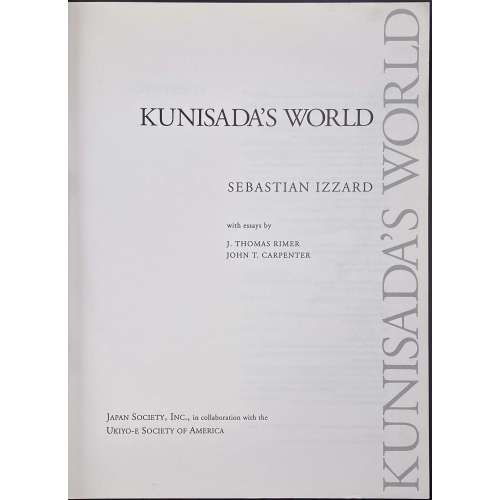 Glossy softcover, publisher’s pictorial wrappers, 30 x 23 cm, pp.: [i-v] vi-xi [xii blank], [2] 3-199 [200 blank], ils.; total 106 leaves. Title-page: Vertical from bottom to top along the outer margin in grey: KUNISADA'S WORLD; horizontally: KUNISADA'S WORLD | SEBASTIAN IZZARD | with essays by | J. THOMAS RIMER | JOHN T. CARPENTER | JAPAN SOCIETY, INC., in collaboration with the | UKIYO-E SOCIETY OF AMERICA || Published in conjunction with an exhibition held at the Japan Society Gallery, New York, September 30 - November 14, 1993. Contents: (1) Kunisada: in and out of his times; Kabuki at the time of Kunisada / J. Thomas Rimer. (2) Popular fiction in the age of Kunisada; Kunisada and the art of comic poetry / John T. Carpenter. (3) Kunisada the artist / Sebastian Izzard. Contributors: Sebastian Izzard J. Thomas Rimer (American, b. 1933) John T. Carpenter (American) Utagawa Kunisada [歌川 国貞] a.k.a. Utagawa Toyokuni III [三代歌川豊国] (Japanese, 1786 – 1865) Select illustrations (references in this collection):
Glossy softcover, publisher’s pictorial wrappers, 30 x 23 cm, pp.: [i-v] vi-xi [xii blank], [2] 3-199 [200 blank], ils.; total 106 leaves. Title-page: Vertical from bottom to top along the outer margin in grey: KUNISADA'S WORLD; horizontally: KUNISADA'S WORLD | SEBASTIAN IZZARD | with essays by | J. THOMAS RIMER | JOHN T. CARPENTER | JAPAN SOCIETY, INC., in collaboration with the | UKIYO-E SOCIETY OF AMERICA || Published in conjunction with an exhibition held at the Japan Society Gallery, New York, September 30 - November 14, 1993. Contents: (1) Kunisada: in and out of his times; Kabuki at the time of Kunisada / J. Thomas Rimer. (2) Popular fiction in the age of Kunisada; Kunisada and the art of comic poetry / John T. Carpenter. (3) Kunisada the artist / Sebastian Izzard. Contributors: Sebastian Izzard J. Thomas Rimer (American, b. 1933) John T. Carpenter (American) Utagawa Kunisada [歌川 国貞] a.k.a. Utagawa Toyokuni III [三代歌川豊国] (Japanese, 1786 – 1865) Select illustrations (references in this collection):
SVJP-0179-3.2014: The Hour of the Tiger, Seventh Hour of Night from the series Twelve Hours of a Modern Clock.

SVJP-0222.2016: A view of the dressing room of a Theater in Dōtonbori, Ōsaka.

SVJP-0105.2014: Ichikawa Danjūrō VIII as the ghost of Seigen.
-
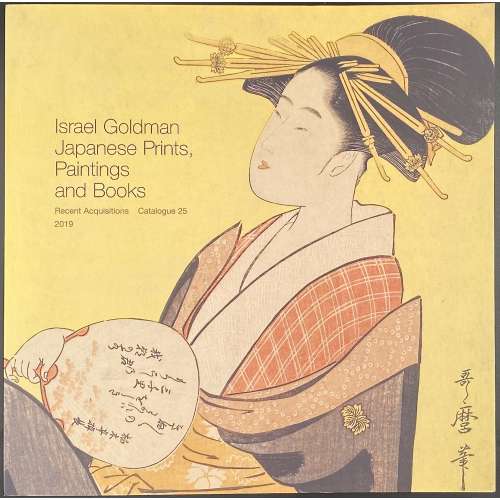 Softcover, pictorial wrappers, square 21 x 21 cm, 42 leaves, unpaginated, with illustrations in colour, 80 entries, with price list laid in; limited edition of 700 copies. Contributor: Israel Goldman
Softcover, pictorial wrappers, square 21 x 21 cm, 42 leaves, unpaginated, with illustrations in colour, 80 entries, with price list laid in; limited edition of 700 copies. Contributor: Israel Goldman -
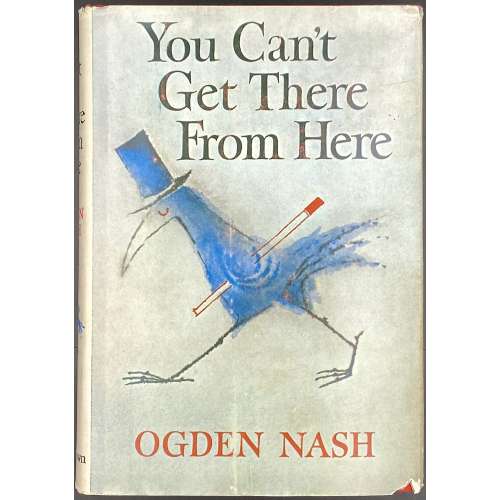 Description: In-8vo volume, 19.4 x 14 cm, bound in red cloth with gilt lettering to front cover and spine, in a pictorial dust jacket with a photo portrait of the author by Kay Bell to the rear, DJ and in-text illustrations by Maurice Sendak; pp. [i-x] xi-xvii [xviii] [2] 3-190, total 208 pages. Dust Jacket front: You Can't | Get There | From Here | {vignette} | OGDEN NASH || Title-page: OGDEN NASH | You Can't Get There | From Here | {vignettes} | DRAWINGS BY MAURICE SENDAK | Boston • LITTLE, BROWN AND COMPANY • Toronto || Edition: 1957, 8th printing; (1st edition in 1953) Contributors: Ogden Nash (American, 1902 – 1971) – author. Maurice Sendak (Jewish-American, 1928 – 2012) – artist. Kay Bell Reynal (American, 1905 – 1977) – photographer.
Description: In-8vo volume, 19.4 x 14 cm, bound in red cloth with gilt lettering to front cover and spine, in a pictorial dust jacket with a photo portrait of the author by Kay Bell to the rear, DJ and in-text illustrations by Maurice Sendak; pp. [i-x] xi-xvii [xviii] [2] 3-190, total 208 pages. Dust Jacket front: You Can't | Get There | From Here | {vignette} | OGDEN NASH || Title-page: OGDEN NASH | You Can't Get There | From Here | {vignettes} | DRAWINGS BY MAURICE SENDAK | Boston • LITTLE, BROWN AND COMPANY • Toronto || Edition: 1957, 8th printing; (1st edition in 1953) Contributors: Ogden Nash (American, 1902 – 1971) – author. Maurice Sendak (Jewish-American, 1928 – 2012) – artist. Kay Bell Reynal (American, 1905 – 1977) – photographer. -
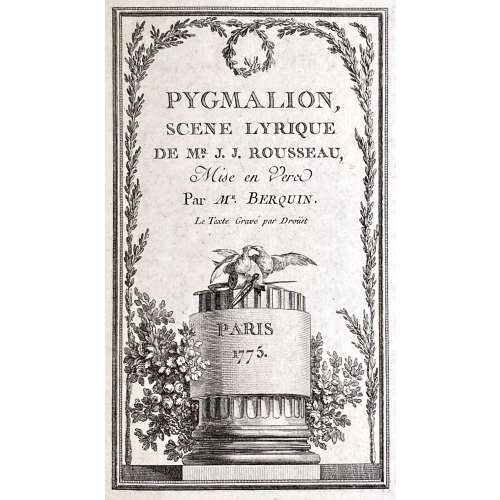 One volume, 22.8 x 15.5 cm, bound in full mottled calf, gilt floral frames to covers, raised bands and gilt fleurons to spine, printed on laid paper. Regarding Pygmalion, scène lyrique see: Wekipedia. Collation: Free endpaper and two blank flyleaves, [2] engraved title, [2] préface, 1-18 (Pygmalion), [2] f.t.p., [1] 2-8 (Idylle), two blank flyleaves and free endpaper; 20 leaves total, adorned with 7 headpieces and 1 tailpiece engraved by Nicolas de Launay, Nicolas Ponce and Charles Etienne Gaucher after Jean Michel Moreau the Younger and Clément Pierre Marillier; text engraved by Droüet. Title-page: PYGMALION, | SCENE LYRIQUE | DE MR. J. J. ROUSSEAU, | Mise en Vers | par MR. Berquin. | Le Text Gravé par Droüet | PARIS | 1775. || (on a column under two kissing doves and sculptor’s tools). Faux t.p.: IDYLLE | Par MR. Berquin. | — | Eructavit cor meum verbum bonum ; | dico ego opera mea regi. | Psalm. 44. | — || (in rules). Catalogue raisonné: Cohen-DeRicci 141 ; Lewine 55. Ref.: MFA (Boston); MET (NY); Yale University Library. Contributors: Artists: Jean-Michel Moreau le Jeune (French, 1741–1814) Clément Pierre Marillier (French, 1740–1808) Engravers: Nicolas Delaunay (French, 1739–1792) Charles-Étienne Gaucher (French, 1741–1804) Nicholas Ponce (French, 1746–1831) Droüet (French, 18th century) Authors: Arnaud Berquin (French, 1747–1791) Jean-Jacques Rousseau (French, 1712–1778)
One volume, 22.8 x 15.5 cm, bound in full mottled calf, gilt floral frames to covers, raised bands and gilt fleurons to spine, printed on laid paper. Regarding Pygmalion, scène lyrique see: Wekipedia. Collation: Free endpaper and two blank flyleaves, [2] engraved title, [2] préface, 1-18 (Pygmalion), [2] f.t.p., [1] 2-8 (Idylle), two blank flyleaves and free endpaper; 20 leaves total, adorned with 7 headpieces and 1 tailpiece engraved by Nicolas de Launay, Nicolas Ponce and Charles Etienne Gaucher after Jean Michel Moreau the Younger and Clément Pierre Marillier; text engraved by Droüet. Title-page: PYGMALION, | SCENE LYRIQUE | DE MR. J. J. ROUSSEAU, | Mise en Vers | par MR. Berquin. | Le Text Gravé par Droüet | PARIS | 1775. || (on a column under two kissing doves and sculptor’s tools). Faux t.p.: IDYLLE | Par MR. Berquin. | — | Eructavit cor meum verbum bonum ; | dico ego opera mea regi. | Psalm. 44. | — || (in rules). Catalogue raisonné: Cohen-DeRicci 141 ; Lewine 55. Ref.: MFA (Boston); MET (NY); Yale University Library. Contributors: Artists: Jean-Michel Moreau le Jeune (French, 1741–1814) Clément Pierre Marillier (French, 1740–1808) Engravers: Nicolas Delaunay (French, 1739–1792) Charles-Étienne Gaucher (French, 1741–1804) Nicholas Ponce (French, 1746–1831) Droüet (French, 18th century) Authors: Arnaud Berquin (French, 1747–1791) Jean-Jacques Rousseau (French, 1712–1778)


